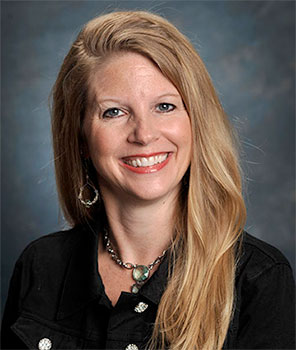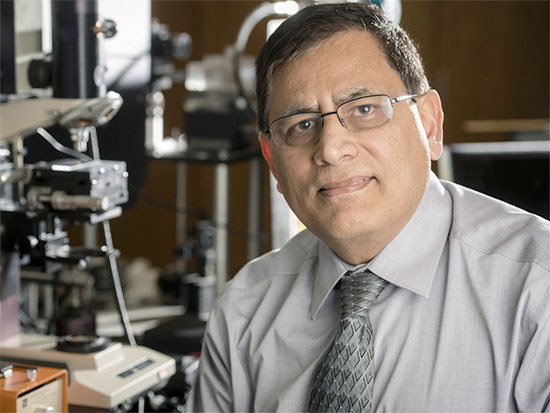 Lori McMahon, Ph.D.Halfway through a meeting at the University of Alabama at Birmingham called NSF Day, panel speaker Lori McMahon, Ph.D., shared her advice on how to successfully compete for federal grants from the National Science Foundation.
Lori McMahon, Ph.D.Halfway through a meeting at the University of Alabama at Birmingham called NSF Day, panel speaker Lori McMahon, Ph.D., shared her advice on how to successfully compete for federal grants from the National Science Foundation.
“Write in a way that is crystal-clear — and that is hard to do,” said McMahon, UAB Graduate School dean and the Jarman F. Lowder Endowed Professor in Neuroscience. “Tell why the work is important and what the impact is.”
The audience comprised 285 researchers and staff from 25 Alabama universities and colleges who had come for an all-day workshop led by 14 visiting officials from all NSF directorates and funding offices to tell how grant funding works, how to identify opportunities and how to write competitive applications.
The NSF is the federal funding source for about one-fourth of all federally supported basic research in America’s colleges and universities, and it has an annual budget of $7.5 billion. As a state, Alabama received $51 million in NSF funding in fiscal year 2017.
Competition is fierce. About 11,000 grants are funded each year out of 49,000 proposals evaluated.
After introductions, the NSF officials spoke about the essentials of grant writing, sections of a proposal and how the merit review of grants works. In that merit review, key elements for a proposal’s success, they say, are intellectual merit and having broader impacts.
The NSF team explained career awards and had an afternoon session on NSF-wide and crosscutting programs. The all-day workshop ended with breakout sessions with individual NSF leaders, according to the areas of their disciplines.
In his morning talk on the essentials of successful grant writing, NSF outreach specialist Jeremy Leffler listed five key elements to consider before writing a proposal:
- Do you have a great idea?
- Does it fit your current research expertise and career development plans?
- Are you able to devise a strategy that includes benchmarks, timelines and metrics?
- Do you have adequate resources?
- Do you have an assessment plan?
 Yogesh Vohra, Ph.D.Andrea Word, Ed.D., clinical assistant faculty in the University of Alabama in Huntsville College of Education, says she found the workshop valuable and enjoyable, including the Q&A sessions scattered throughout the day.
Yogesh Vohra, Ph.D.Andrea Word, Ed.D., clinical assistant faculty in the University of Alabama in Huntsville College of Education, says she found the workshop valuable and enjoyable, including the Q&A sessions scattered throughout the day.
“It’s the first such event I have attended, and I found the presentations by the directorate representatives helpful, both in outlining their respective missions and in providing a comprehensive view of the agency’s mission itself,” Word said. “The insights provided by the panel of funded researchers have already impacted the way I am approaching a proposal we have in the works here at UAH.”
One of the funded panel members was Yogesh Vohra, Ph.D., a professor and university scholar in the UAB Department of Physics. Vohra advised researchers to start their proposals four to six months before the due date and seek an external review by colleagues before submitting to NSF.
Word also found the afternoon breakouts helpful. “At the breakout session for the NSF’s Education and Human Resources, Dr. Karen Keene shared insights that are already helping me re-vision the programs within which my work might be best situated. That alone was worth the trip down!”
Jessica Parker, a contract and grant specialist at Auburn University, called the NSF Day “all-encompassing and enlightening.”
“I am a research administrator who helps faculty who have many different research areas find funding,” Parker said. “NSF does a wonderful job at providing opportunities to institutions to ask questions and provide feedback. I was really thankful that UAB was able to host this event.”
The Alabama researchers and staff at the workshop included 68 from UAB, 42 from the University of South Alabama, 39 from the University of Alabama, 30 from Auburn University, 30 from Alabama State University, 17 from the University of Alabama in Huntsville, 16 from Tuskegee University, eight from Samford University, and four or fewer from 16 other Alabama schools. There were also seven attendees from universities in Florida, Georgia, Massachusetts, New York, Nepal and Slovenia.
The sponsor for NSF Day was Alabama EPSCoR, a consortium dedicated to the advancement of scientific and engineering research that includes the eight Alabama Ph.D.-granting institutions, together with the Economic Development Partnership of Alabama, the Alabama Commerce Department and the Alabama Commission on Higher Education.
NSF funds for research and research infrastructure are part of Alabama’s steps to transform itself into a high-technology economy, says Christopher Lawson, Ph.D., a UAB physics professor. Lawson serves as executive director of Alabama EPSCoR.
In addition to sponsoring outreach workshops such as NSF Day and funding 30 to 40 graduate student scholarships per year across the state, Alabama EPSCoR works to improve Alabama’s research infrastructure and national research competitiveness through federal EPSCoR research and education grants. These have recently brought in between $12 million and $18 million per year of research funding or expenditures to the state.